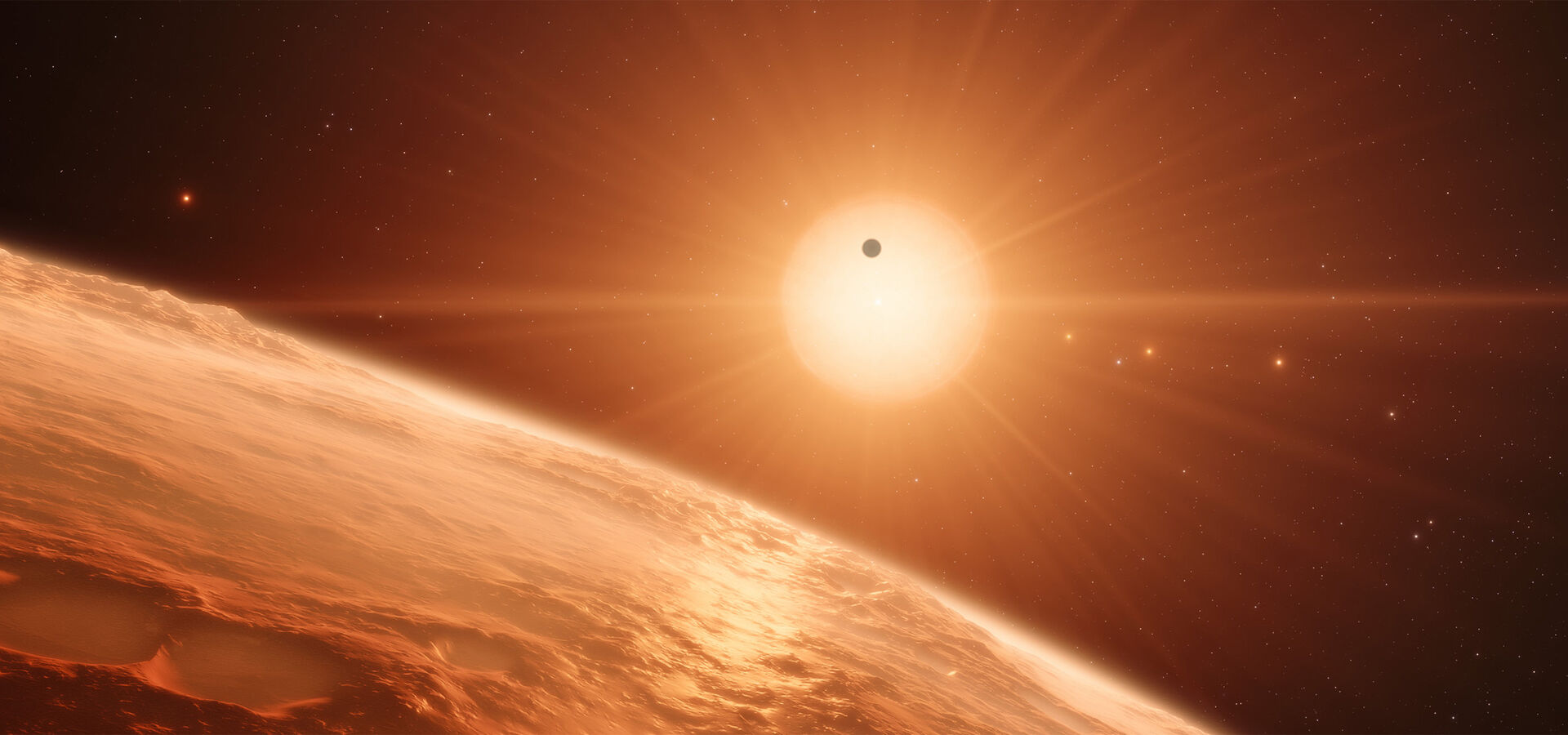
European
Southern
Observatory


Are we alone in the Universe? For millennia, this question was not posed or was purely philosophical. Recently, astronomers have started to provide an answer.
With the ELT, for the first time in history, technology allows us to observe and characterise exoplanets in habitable zones. It could even become the first telescope to find evidence of extraterrestrial life on these planets.
With the ELT, for the first time in history, technology allows us to observe and characterise exoplanets in habitable zones. It could even become the first telescope to find evidence of extraterrestrial life on these planets.
Are we alone in the Universe? For millennia, this question was not posed or was purely philosophical. Recently, astronomers have started to provide an answer.
With the ELT, for the first time in history, technology allows us to observe and characterise exoplanets in habitable zones. It could even become the first telescope to find evidence of extraterrestrial life on these planets.
The first exoplanet orbiting a solar-type star (51 Pegasi) was discovered in 1995 by Michel Mayor and Didier Queloz, who received the Nobel Prize in Physics in 2019 for this breakthrough. Since then, over 4000 planets have been found orbiting stars other than our Sun — from super Jupiters to Earth and Mars-size planets, including the debated discovery of the first exomoon, a moon around an exoplanet.
Most exoplanets are detected indirectly by the radial velocity method, which detects planets by the wobble they produce on their parent star as they orbit it. Another method used by astronomers is the transit technique, which detects the drop in brightness of the host star when a planet passes in front of it. However, these detections are indirect and very limited in the information they can provide about the planet itself. In addition, very few direct observations of planets have been made.
The ELT will revolutionise the study of planets outside our Solar System. It will allow us to obtain direct images of some of these systems, including of planets in the habitable zones of a star — rocky planets within this range of orbits might hold liquid water on their surface. Thanks to the very large collecting power of the ELT, we will also be able to detect and characterise the fingerprints of transiting planets’ atmospheres as they pass in front of their parent star.
The radial velocity technique, which measures the induced Doppler shift of features in the spectrum of the parent star, can only find certain kinds of planets.
With the current generation of telescopes, this technique is limited both by the precision and the stability of the velocity measurements: current measurements have pushed the limit down to an already impressive ~20 cm/s precision retained over several years. The challenge, however, is that a planet like the Earth, orbiting a star like the Sun, will only induce a radial velocity variation of about half this value. This lies at the limit of what can be achieved with current telescopes, even when equipped with next-generation instruments. In contrast, ultra-stable spectrographs on the ELT, profiting from the telescope’s large collecting power, will achieve measurement precisions of ~1 cm/s over periods ranging from minutes to years. For the detection of rocky planets in habitable zones, this precision is needed to overcome measurement contamination by oscillations, seismology, granulation and magnetic activity of the parent star.
Thus, the ELT is essential for characterising telluric exoplanets, including the first probable Earth twins in the habitable zones of nearby stars. The ELT will enable us to investigate the basic physical and chemical properties of exoplanets like their orbital parameters and internal structures, temperature profiles, composition of their atmospheres, weather, seasons and possibly indications for life. It will provide an understanding of the architecture, the formation and the evolution of planetary systems and will provide an answer to an important part of the fundamental question: just how unique are we?
By 2026, ground- and space-based facilities will have discovered thousands of additional telluric and giant exoplanets. The ELT will start detecting Earth-twin targets in habitable zones using the radial velocity and transit techniques described above.
By then, the statistical understanding of the properties of the parent stars and the distributions of the masses and orbits of exoplanets will have matured. The next step in exoplanet research will be the physical characterisation of the then-known planets. To achieve this, direct light from the planet must be detected and separated from the glare of its parent star. Overcoming this difference in brightness (usually referred to as the contrast) is the main challenge for this type of observation and requires extremely sharp imaging. This capability will be a huge strength of ground-based telescopes. Planet-finder instruments on 8-metre-class telescopes now routinely achieve similar contrasts to the James Webb Space Telescope: around 10–5 to 10–6 at sub-arcsecond distances from the parent stars.
The detection of an Earth-twin requires a contrast of 10–9 or better within less than 0.1 arcseconds from the star. The unprecedented light-gathering power of a 40-metre-class telescope and the implementation of extreme adaptive optics in the ELT are crucial to reaching this limit. A planet-finder instrument on the ELT will allow scientists not only to study young (self-luminous) and mature giant planets in the solar neighbourhood and out to the closest star-forming regions but also to understand the composition and structure of their atmospheres. Around the nearest hundred stars, the ELT will enable the first characterisation of Neptune-like planets and rocky planets located in habitable zones, establishing a new frontier in astrobiology and in our understanding of the evolution of life.
With the ELT, the detailed study of the atmospheres of young, telluric and massive exoplanets will intensify. Indeed, with its unprecedented sensitivity and spatial resolution at mid-infrared wavelengths, the ELT will be able to detect young, self-luminous exoplanets of Jupiter-mass, but also giant and telluric ones in reflected light. In optical and infrared, various molecular signatures will be accessible at low and high spectral resolutions including carbon monoxide and dioxide, methane, water, ammonia and even oxygen in the spectra of the atmospheres of Jupiter, Neptune and Earth-like planets in habitable zones.
Alternatively, exoplanet atmospheres can be observed during transits. Ground- and space-based facilities (such as the now-retired French-led CoRoT and NASA’s Kepler missions, the European Space Agency’s [ESA’s] CHEOPS, and the future ESA missions PLATO and ARIEL) are accumulating target stars for which an exoplanet, as seen from Earth, transits in front of its parent star. During these events, which last a few hours every few months or years, spectral features of the exoplanet’s atmosphere, back-lit by their parent star, can be seen in the spectrum of the system. Such measurements are challenging but have already been done for giant planets by 8-metre-class telescopes. Extending these measurements to the regime of terrestrial planets is a possibility within reach of the ELT. For such planets, and for those lying in the habitable zone, the spectra may then be examined for the biomarker molecules that are indicative of biological processes, offering another alternative to make the first detection of extraterrestrial life.
The observed diversity in the properties of exoplanets must be related to the structure and evolution of the discs of preplanetary material from which they form. A crucial step for our understanding of the origin of life is thus the study of the formation of such protoplanetary discs. The transition from the gas-rich to the gas-poor phase of discs is of particular interest: it is the time when gaseous planets form and rocky planets gradually accrete solid material, either in the form of planetesimals — essentially similar to present-day asteroids or comets — or much smaller pebbles (a few centimetres in size).
The ELT’s spatial resolution, of a few to tens of milliarcseconds, allows it to probe the inner few astronomical units of these discs, out to the nearest star-forming regions (at about 500 light-years from us), allowing us to, for the first time, explore the regions where Earth-like planets form. These data will beautifully complement observations acquired with the international Atacama Large Millimeter/submillimeter Array (ALMA), in which ESO is a partner, looking at the colder material further out in these systems, to provide a full understanding of protoplanetary disc evolution. Furthermore, the inner discs probed by the ELT are those where the key molecules for organic chemistry, such as methane, acetylene, and hydrogen cyanide, occur, and more complex, prebiotic molecules are expected to form. Their study will provide a further vital piece in the astrobiology puzzle.
We use cookies that are essential for accessing our websites and using our services. We also use cookies to analyse, measure and improve our websites’ performance, to enable content sharing via social media and to display media content hosted on third-party platforms.
The European Organisation for Astronomical Research in the Southern Hemisphere (ESO) is the pre-eminent intergovernmental science and technology organisation in astronomy. It carries out an ambitious programme focused on the design, construction and operation of powerful ground-based observing facilities for astronomy.
This Cookies Policy is intended to provide clarity by outlining the cookies used on the ESO public websites, their functions, the options you have for controlling them, and the ways you can contact us for additional details.
Cookies are small pieces of data stored on your device by websites you visit. They serve various purposes, such as remembering login credentials and preferences and enhance your browsing experience.
Essential cookies (always active): These cookies are strictly necessary for the proper functioning of our website. Without these cookies, the website cannot operate correctly, and certain services, such as logging in or accessing secure areas, may not be available; because they are essential for the website’s operation, they cannot be disabled.
Functional Cookies: These cookies enhance your browsing experience by enabling additional features and personalization, such as remembering your preferences and settings. While not strictly necessary for the website to function, they improve usability and convenience; these cookies are only placed if you provide your consent.
Analytics cookies: These cookies collect information about how visitors interact with our website, such as which pages are visited most often and how users navigate the site. This data helps us improve website performance, optimize content, and enhance the user experience; these cookies are only placed if you provide your consent. We use the following analytics cookies.
Matomo Cookies:
This website uses Matomo (formerly Piwik), an open source software which enables the statistical analysis of website visits. Matomo uses cookies (text files) which are saved on your computer and which allow us to analyze how you use our website. The website user information generated by the cookies will only be saved on the servers of our IT Department. We use this information to analyze www.eso.org visits and to prepare reports on website activities. These data will not be disclosed to third parties.
On behalf of ESO, Matomo will use this information for the purpose of evaluating your use of the website, compiling reports on website activity and providing other services relating to website activity and internet usage.
Matomo cookies settings:
Additional Third-party cookies on ESO websites: some of our pages display content from external providers, e.g. YouTube.
Such third-party services are outside of ESO control and may, at any time, change their terms of service, use of cookies, etc.
YouTube: Some videos on the ESO website are embedded from ESO’s official YouTube channel. We have enabled YouTube’s privacy-enhanced mode, meaning that no cookies are set unless the user actively clicks on the video to play it. Additionally, in this mode, YouTube does not store any personally identifiable cookie data for embedded video playbacks. For more details, please refer to YouTube’s embedding videos information page.
Cookies can also be classified based on the following elements.
Regarding the domain, there are:
As for their duration, cookies can be:
Cookie settings: You can modify your cookie choices for the ESO webpages at any time by clicking on the link Cookie settings at the bottom of any page.
In your browser: If you wish to delete cookies or instruct your browser to delete or block cookies by default, please visit the help pages of your browser:
Please be aware that if you delete or decline cookies, certain functionalities of our website may be not be available and your browsing experience may be affected.
You can set most browsers to prevent any cookies being placed on your device, but you may then have to manually adjust some preferences every time you visit a site/page. And some services and functionalities may not work properly at all (e.g. profile logging-in, shop check out).
The ESO Cookies Policy may be subject to future updates, which will be made available on this page.
For any queries related to cookies, please contact: pdprATesoDOTorg.
As ESO public webpages are managed by our Department of Communication, your questions will be dealt with the support of the said Department.